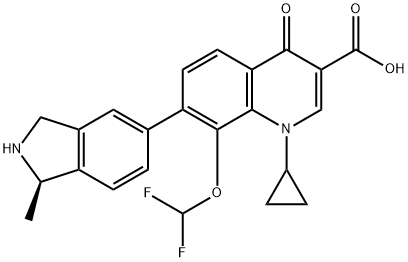Garenoxacin is a new quinolone antimicrobial agent that exhibits a
broad spectrum of activity against both Gram-negative and Gram-positive
organisms, including the important community-acquired respiratory pathogens
S.pneumoniae, Haemophilus influenzae, and Moraxella catarrhalis. In addition, it has
potent activity against several resistant strains such as multidrug-resistant
S.pneumoniae, methicillin-resistant S.aureus (MRSA), and vancomycin-resistant
enterococci (VRE). It was launched in Japan as an oral treatment for respiratory tract and otorhinolaryngological infections. As with other quinolone antibiotics marketed in recent years, the mechanism of action of garenoxacin involves dual inhibition of two essential bacterial enzymes, DNA gyrase and topoisomerase IV. The lack of 6-fluoro substituent does not adversely affect its potency of inhibiting DNA gyrase (Escherichia coli, IC50 0.17 mg/mL) or topoisomerase IV (S. aureus, IC50 2.19 mg/ mL).
In human pharmacokinetic studies, oral garenoxacin results in dose-proportionate increases of plasma Cmax and AUC values at doses ranging from 50 to 1,200 mg. Its oral bioavailability is about 95%, and the mean terminal half-life is 15.4 h.
The most common adverse events associated with garenoxacin were rash, dizziness, nausea, headache, and pruritus. Garenoxacin is chemically derived in a sequence of 14 steps, 12 of which entail the construction of a key quinolone intermediate, 7-bromo-1- cyclopropyl-8-(difluoromethoxy)-1,4-dihydro-4-oxoquinoline-3-carboxylic acid ethyl ester. Subsequently, Suzuki cross-coupling reaction of this intermediate with (R)-[1-methyl-2-(trityl)isoindolin-5-yl]boronic acid, followed by deprotection of the trityl group and ester hydrolysis with hydrochloric acid gives garenoxacin. The chiral isoindoline reagent is obtained from racemic 5-bromo-2-methylisoindoline via coupling with N-CBZ-L-phenylalanine, separation of diastereomers by chromatography, cleavage of the chiral auxiliary, N-tritylation, halogen-metal exchange with butyllithium, and boronation with triisopropyl borate.

